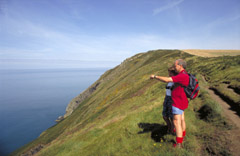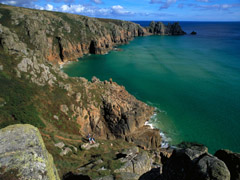Britain’s Walks and Trails
Great British Walks Britains National Trails are the grand-daddies of long distance paths. This year there is a new one, following a rugged frontier of the Roman Empire; while another around the coastline of South West England is marking its 25th anniversary. What better excuse to come on a walking holiday? Fresh-air fanatics can take to the highlands of Scotland, or follow the Pennine Hills across the backbone of England, or scramble in rocky Snowdonia, North Wales, where the team that first conquered Mount Everest did their training. I prefer the walks that roll down off a grassy ridge into a picturesque village, which — unless youre very unlucky — will have its cosy country pub serving good beer and food. I also love the breezy coastal trails that track past untouched cliffs and beaches rich in wildlife. Take your binoculars on paths like these, and youll catch sight of seals, dolphins and all manner of seabirds. Britain is a walker-friendly country. Its easy to escape to the hills by following hundreds — no, thousands — of trails that come in all shapes and sizes. At the top of the tree are the 13 National Trails, the variety of which mirrors the countrys ever-changing landscapes. Varying in length from 79 to 630 miles (126 1014 km), they take in everything from chalk downlands to rugged mountainsides, sandy bays to river meadows.  Dont be put off by the length. Most walkers prefer to choose short sections of these waymarked paths and come back for more another time. Britains newest National Trail, up on Hadrians Wall in the moors where England meets Scotland, is 84 miles (134 km) long, but most walkers will only cover a few miles at a time, or some of the 40 circular walks that loop off the main track. Opened in May 2003, the trail runs the entire length of the great fortification built by the Romans in the 2nd century to control their northern frontier. Today, it is still wild, remote countryside. My favourite stretch crosses the sharp escarpment of Great Whin Sill, where youre accompanied not just by Northumbrias big skies and wide, open spaces but also by some of the best-preserved sections of surviving wall which, in its prime, stood 15 feet high. Theres another reason for choosing this particular part of the trail. On Whin Sills slope theres Housesteads, the most complete Roman fort in Britain, its bare bones laid out to give a rare insight into life in this ancient outpost. The trail runs from the friendly city of Newcastle upon Tyne to Bowness-on-Solway on the west coast, passing close to attractive old country towns like Hexham and Brampton and the historic city of Carlisle — so theres a good choice of places to stay (from hostels, farmhouses and bed-and-breakfasts to stylish city hotels).
Dont be put off by the length. Most walkers prefer to choose short sections of these waymarked paths and come back for more another time. Britains newest National Trail, up on Hadrians Wall in the moors where England meets Scotland, is 84 miles (134 km) long, but most walkers will only cover a few miles at a time, or some of the 40 circular walks that loop off the main track. Opened in May 2003, the trail runs the entire length of the great fortification built by the Romans in the 2nd century to control their northern frontier. Today, it is still wild, remote countryside. My favourite stretch crosses the sharp escarpment of Great Whin Sill, where youre accompanied not just by Northumbrias big skies and wide, open spaces but also by some of the best-preserved sections of surviving wall which, in its prime, stood 15 feet high. Theres another reason for choosing this particular part of the trail. On Whin Sills slope theres Housesteads, the most complete Roman fort in Britain, its bare bones laid out to give a rare insight into life in this ancient outpost. The trail runs from the friendly city of Newcastle upon Tyne to Bowness-on-Solway on the west coast, passing close to attractive old country towns like Hexham and Brampton and the historic city of Carlisle — so theres a good choice of places to stay (from hostels, farmhouses and bed-and-breakfasts to stylish city hotels).  For many of us, walking can become almost a spiritual experience. St Davids, in the south-west of Wales, is imbued with the Celtic atmosphere that enfolds the ancient rocks and rugged seascapes of Pembrokeshires shores, or the lingering memory of early Christian saints who settled here. My favourite coastal walk takes in the peninsula around St Davids, the tiny cathedral city named after Waless patron saint. Follow this particular stretch of the 186-mile (300 km) Pembrokeshire Coast Path and for the next few hours youll feel as though youre walking on air as the route takes you past golden beaches, remote coves, religious shrines and salty headlands. Although small and utterly peaceful, St Davids is blessed with a wide range of accommodation including country house hotels and farmhouses. Back in England, the South West Coast Path National Trail starts in an altogether busier place — the seaside resort of Minehead on the Somerset coast. But within a few miles of the starting point (marked by a startling new sculpture — a pair of giant hands holding a map) youre up in the clouds cresting the highest sea-cliffs in England, then down amongst the oakwoods in the countrys thickest coastal forests. This year you can help celebrate the 25th anniversary of the path, which winds its way for 630 miles (1014 km) around the south-western finger of Britain to Poole Harbour in Dorset. And because it takes in the popular holiday counties of Devon and Cornwall youll find plentiful accommodation en route. The essence of England is also to be found on the rolling downlands of the Ridgeway National Trail, which runs for 85 miles (137 km) across the North Wessex Downs and Chiltern Hills from Avebury, with its prehistoric stone circles, to Ivinghoe Beacon. Its easy walking and easy to get to, for the Ridgeway runs close to some popular tourist centres, including Bath and Oxford. It is Britains oldest road, which has existed for thousands of years: follow in the footsteps of prehistoric man, medieval farmers and 17th-century drovers.
For many of us, walking can become almost a spiritual experience. St Davids, in the south-west of Wales, is imbued with the Celtic atmosphere that enfolds the ancient rocks and rugged seascapes of Pembrokeshires shores, or the lingering memory of early Christian saints who settled here. My favourite coastal walk takes in the peninsula around St Davids, the tiny cathedral city named after Waless patron saint. Follow this particular stretch of the 186-mile (300 km) Pembrokeshire Coast Path and for the next few hours youll feel as though youre walking on air as the route takes you past golden beaches, remote coves, religious shrines and salty headlands. Although small and utterly peaceful, St Davids is blessed with a wide range of accommodation including country house hotels and farmhouses. Back in England, the South West Coast Path National Trail starts in an altogether busier place — the seaside resort of Minehead on the Somerset coast. But within a few miles of the starting point (marked by a startling new sculpture — a pair of giant hands holding a map) youre up in the clouds cresting the highest sea-cliffs in England, then down amongst the oakwoods in the countrys thickest coastal forests. This year you can help celebrate the 25th anniversary of the path, which winds its way for 630 miles (1014 km) around the south-western finger of Britain to Poole Harbour in Dorset. And because it takes in the popular holiday counties of Devon and Cornwall youll find plentiful accommodation en route. The essence of England is also to be found on the rolling downlands of the Ridgeway National Trail, which runs for 85 miles (137 km) across the North Wessex Downs and Chiltern Hills from Avebury, with its prehistoric stone circles, to Ivinghoe Beacon. Its easy walking and easy to get to, for the Ridgeway runs close to some popular tourist centres, including Bath and Oxford. It is Britains oldest road, which has existed for thousands of years: follow in the footsteps of prehistoric man, medieval farmers and 17th-century drovers.  Its the same story throughout England and Wales, where youre never more than 50 miles (80 km) from a National Trail. There is even one through the centre of London: the Thames Path that follows the river to its source in the Cotswold Hills. There are countless shorter trails, too: forest paths, nature trails and waymarked walks waiting to be explored. So do yourself a favour and pack your walking boots when you come to Britain. Theres no better way of getting to grips with the country. If you lack the time or confidence to plan your own independent walks, there are a number of operators who specialise in organised walking tours luxury or budget, gentle-paced or energetic. Every detail is taken care of: they even carry your luggage between stops. Either way, a good starting point is VisitBritains website: www.visitbritain.com/outdoor. Other useful websites www.nationaltrail.co.uk www.hadrians-wall.org www.nationaltrails.gov.uk www.visitbritain.com/outdoor
Its the same story throughout England and Wales, where youre never more than 50 miles (80 km) from a National Trail. There is even one through the centre of London: the Thames Path that follows the river to its source in the Cotswold Hills. There are countless shorter trails, too: forest paths, nature trails and waymarked walks waiting to be explored. So do yourself a favour and pack your walking boots when you come to Britain. Theres no better way of getting to grips with the country. If you lack the time or confidence to plan your own independent walks, there are a number of operators who specialise in organised walking tours luxury or budget, gentle-paced or energetic. Every detail is taken care of: they even carry your luggage between stops. Either way, a good starting point is VisitBritains website: www.visitbritain.com/outdoor. Other useful websites www.nationaltrail.co.uk www.hadrians-wall.org www.nationaltrails.gov.uk www.visitbritain.com/outdoor
by Roger Thomas

